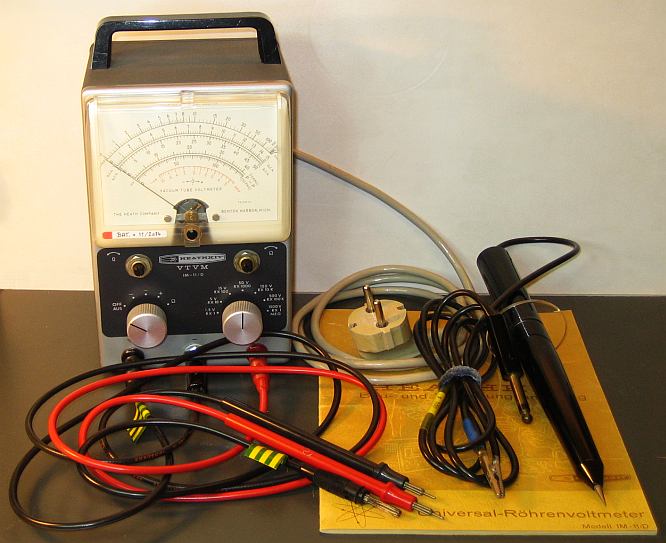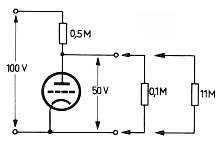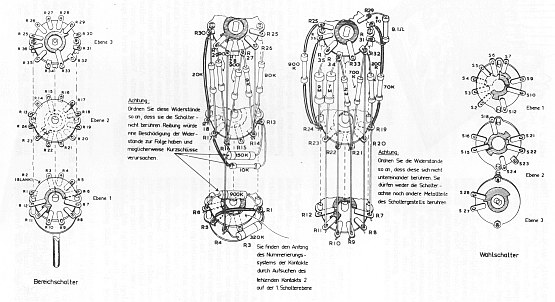previous <<==>> next
VACUUM-TUBE VOLTMETER
» HEATHKIT IM-11/D «

The picture shows on the right the HIGH-VOLTAGE (x100)-PROBE, Max. = 30 kV V A C U U M - T U B E VOLTMETER » IM-11/D « Self-Assembled » HEATHKIT « *************************************************************************** German Version by DAYSTROM GmbH, Sprendlingen b. Frankfurt am Main ( 1963 ) Voltage Ranges: 0 .. 1.5 ; 5 ; 15 ; 50 ; 150 ; 500 ; 1500 V DC/AC Resistor Ranges: (x1); (x10); (x100); (x1000); (x10k); (x100k); (x1M) Ω Resistor Battery: 1.5 V "Baby Cell" ( C ) Input-Resistance: 11 MΩ; Precision: 3%(DC)/5%(AC); Power: 220 V AC ; 10 W Dimension ( W x H x D ) 4_3/4" x 8_3/4" x 5" / 12 cm x 22 cm x 13 cm The » IM-11/D « DIAGRAM ... |

R E M A R K S : Why a VACUUM-TUBE VOLTMETER = "VTVM" ???
===========================================================================
An AMPERE-Meter has to have a very low inner resistance "R-Instr" - and a
VOLT-Meter has to have a very high inner resistance - specially, when the
inner resistance of the object to be measured is high. E X A M P L E :
Let the voltage on a vacuum-tube be "true" +50 V, than the inner resistance
of this vacuum-tube is 0.5 MΩ ...
|
 Measuring the VOLTAGE ON THE TUBE with a VoltMeter has the effect, that the
total current splits: I-Total = I-Object + I-Instr.
Case (A)
--------
A "normal" instrument with 1 kΩ/V in its 100 V Range, connected parallel,
will result in a 0.5 MΩ || 0.1 MΩ = 83.3 kΩ a small resistance! The
measured voltage Ux we get out of the proportion ...
Ux / 100 V = 83.3 kΩ / ( 500 kΩ + 83.3 kΩ )
Ux = 100 V * ( 83.3 kΩ / 583.3 kΩ ) = 14.3 V
A very bad result! As higher "R-Instr", as more precise the measurement...
Case (B)
--------
A "VTVM" has a high inner resistance, eg. 11 MΩ ...
0.5 MΩ || 11 MΩ = 0.48 MΩ only 4% less, makes a better result !
In the 60's, this "VTVM" was a hit: Who had to repair vacuum-tubed RADIOs
or TVs needed a VTVM. I bought this as a KIT for self-assembling/soldering
in 1963. Have a look at a DETAIL IN ITS MANUAL: WIRING THE SWITCHES ...
Measuring the VOLTAGE ON THE TUBE with a VoltMeter has the effect, that the
total current splits: I-Total = I-Object + I-Instr.
Case (A)
--------
A "normal" instrument with 1 kΩ/V in its 100 V Range, connected parallel,
will result in a 0.5 MΩ || 0.1 MΩ = 83.3 kΩ a small resistance! The
measured voltage Ux we get out of the proportion ...
Ux / 100 V = 83.3 kΩ / ( 500 kΩ + 83.3 kΩ )
Ux = 100 V * ( 83.3 kΩ / 583.3 kΩ ) = 14.3 V
A very bad result! As higher "R-Instr", as more precise the measurement...
Case (B)
--------
A "VTVM" has a high inner resistance, eg. 11 MΩ ...
0.5 MΩ || 11 MΩ = 0.48 MΩ only 4% less, makes a better result !
In the 60's, this "VTVM" was a hit: Who had to repair vacuum-tubed RADIOs
or TVs needed a VTVM. I bought this as a KIT for self-assembling/soldering
in 1963. Have a look at a DETAIL IN ITS MANUAL: WIRING THE SWITCHES ...
 After a plastic knob broke, I replaced both with METAL KNOBS. Since then,
this »IM-11/D« is reliable, durable and in use 50 years ...
( In 80's I got a modern DIGITAL-VM ... It failed after warrant was over !)
=================================================
After a plastic knob broke, I replaced both with METAL KNOBS. Since then,
this »IM-11/D« is reliable, durable and in use 50 years ...
( In 80's I got a modern DIGITAL-VM ... It failed after warrant was over !)
=================================================